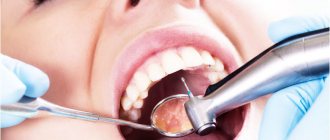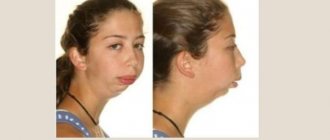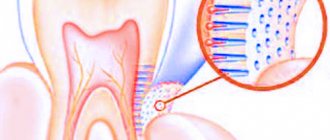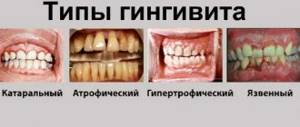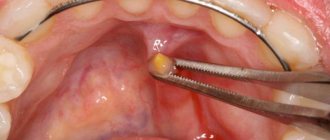Pain in the temporomandibular joint
Temporomandibular joint dysfunction (TMJ) is one of the most common causes of facial pain and is often incorrectly referred to as temporomandibular dysfunction. There are 2 main types of TMJ dysfunction: myogenic (the source of muscle pain) and arthrogenic (the source of pain is the TMJ). Understanding TMJ Dysfunction
This disorder involves the presence of the following symptoms: - pain or discomfort in or around the ear, TMJ and/or muscles of the jaw, face, temple area and neck on one or both sides.
Pain can occur unexpectedly and increase in frequency and intensity over months and years. Mouth opening with a click, crepitus, closing, restriction of opening or deviation of the lower jaw during movement, difficulty chewing, and headache are also associated with TMJ. Structure of the TMJ The
temporomandibular joint, or TMJ, is a freely rotating and sliding joint, covered with fibrocartilage, a football-shaped ball (condyle), a fibrous pad (disc), a bone socket for the pad (fossa), ligaments, tendons, blood vessels and nerves.
The disc functions as a moving shock absorber and stabilizer between the condyle and fossa. When the jaw opens, the condyle normally rotates first and then slides forward within the fossa with a disc located between the condyle and the fossa. Muscles of mastication
Muscles attached to the lower, upper jaw, skull and neck.
The muscles of mastication open, close, extend, and move your jaw, allowing you to speak, chew, and swallow. The accessory muscles of mastication (neck and shoulder muscles) stabilize the skull on the neck during chewing. Myogenic TMJ dysfunction (muscle-related)
Typically occurs due to overuse, fatigue, or tension in the masseter or accessory muscles, resulting in facial pain, headaches, and sometimes neck pain.
Arthrogenic TMJ dysfunction (joint-related)
Typically results from inflammation and degenerative changes in the hard and soft tissues of the joint.
Capsulitis or synovitis (inflammation), slipped disc (also called internal injury) and degenerative arthritis are the most common causes of TMJ dysfunction. Causes of TMJ Dysfunction The exact causes of TMJ
dysfunction are still unclear.
It is believed that the development of dysfunction is due to a combination of several severe factors, including injury and joint disease. Teeth clenching and grinding (bruxism), as well as tension in the neck and head muscles, are currently not proven causes of TMJ dysfunction, but they can aggravate the symptoms of this disease and must be taken into account in the treatment and management of patients with this pathology. It is important for patients with this dysfunction to understand that this disease can be chronic and can be very dependent on many factors, including emotional stability. Because there is no quick fix or emergency treatment for TMJ, the most successful and expert-supported treatments focus on self-monitoring and managing aggravating symptoms. Factors Associated with TMJ Dysfunction
- Trauma: Direct trauma to the jaw is associated with symptoms of dysfunction.
Direct trauma to the jaw can occur from a blow to the jaw, hyperextension (strain) of the jaw, and in some cases, compression of the jaw. Prolonged or forceful dental procedures, intubation during general anesthesia, and surgical procedures of the mouth, throat, and upper gastrointestinal tract (esophagus and stomach) can injure the TMJ. — Incorrect habits: Habits such as clenching teeth, clenching the jaw, grinding teeth (bruxism), biting lips or nails, chewing gum, and placing the jaw in abnormal positions are common. In relation to them, evidence of their involvement in the development of dysfunction has not been proven. Such habits are often associated with TMJ dysfunction and can contribute to the emergence of factors that translate into a chronic form and aggravate the existing symptoms of the pathology. — Occlusion: Dental occlusion refers to the way the teeth fit together or “bite.” Historically, dentists have viewed malocclusion as the primary cause of TMJ dysfunction. Recent studies have shown that malocclusion does not usually lead to this group of diseases, with the exception of a few cases. Each situation must be considered individually so that the doctor can make a differential diagnosis of facial pain. — Psychological factors: Many patients with TMJ dysfunction say that the onset of symptoms of the disease or worsening of its course is accompanied by an increase in emotional stress and psychological imbalance, leading to depression or anxiety. Scientific research shows that many patients with this dysfunction experience varying levels of depression and anxiety, and these levels are higher than those without this dysfunction. To date, it has not been established whether symptoms of depression or anxiety are present before the onset of TMJ dysfunction and then contribute to its formation, or whether chronic pain associated with this pathological condition leads to the formation of anxiety and depression. Many patients begin to clench and grind their teeth more frequently and intensely when they experience emotional stress, psychological imbalance, or pain. — Disorders of the temporomandibular joint: Some types of arthritis can lead to damage to the TMJ, as well as other joints. This is common in osteoarthritis developing in the aging population. Many other diseases, such as Parkinson's disease, myasthenia gravis, strokes, amyotrophic lateral sclerosis, can lead to excessive or uncontrolled movements of the masticatory muscles. — Other factors: Drug use and some prescribed medications can affect the central nervous system and muscles, and lead to TMJ dysfunction. Diagnosis of TMJ dysfunction.
Diagnosis of this disease should be part of routine practice among general practitioners and dentists.
A short set of diagnostic procedures may include: - History of the disease: complaints of pain in the jaw, headaches, neck pain, discomfort in the TMJ area, jaw closing, clenching of teeth, damage to the jaw, head, neck, as well as a history of cases of TMJ dysfunction or treatment of facial pain. - Objective examination: may include measurement of jaw opening, combined movements, jaw deviation during opening, palpation (finger pressure required) of the joint, jaw, head and neck muscles to determine pressure points and the presence of crepitus. It is also necessary to evaluate the gums, soft tissues of the mouth, teeth and make notes about the disease, the presence of dental lesions, as well as the symmetry of the jaw, face and head. If any abnormalities are found during the examination, a more detailed history should be collected and a more in-depth examination performed. Comprehensive assessment of TMJ dysfunction A comprehensive assessment may include:
- A complete analysis of all symptoms related to TMJ, head, neck, medical history, dental history, life history, heredity, psychological history.
— Comprehensive objective examination of the face, cervical spine, masticatory muscles, head and neck, neurological structures, teeth, gums, hard and soft tissues of the oral cavity. — Psychological history, including a short survey and testing. — Additional tests, including x-rays and imaging tests, biopsies, blood tests, urine tests, neurological tests, diagnostic injections. Treatment of TMJ dysfunction
Since there is no known cure for this pathology, the management of patients with symptoms of dysfunction is similar to the management of patients with other orthopedic or rheumatological disorders.
The goals of managing this group of patients are: reducing pain, adverse pressure and stress on the jaws, restoring jaw function, implementing a well-planned management program to treat the physical, emotional and psychological aspects. Management options and sequence of treatment for TMJ dysfunction are similar to other musculoskeletal diseases. As with many musculoskeletal disorders, the signs and symptoms of TMJ can be temporary and resolve on their own without developing serious long-term consequences. For these reasons, it is particularly important to try to avoid aggressive and irreversible treatment options such as surgery, major dental surgery or orthodontic treatment. Conservative management techniques include changes in behavioral habits, physical activity, medications, jaw exercises, and orthopedic devices. All of them have been found to be safe and effective treatments for cases of TMJ dysfunction. Most patients suffering from this disease achieve long-term remission with conservative therapy. Scientific studies show that in more than 50% of such patients, only a few symptoms persist or disappear completely. Self-monitoring of patients should include: - Limited jaw opening (no more than 2 fingers wide). — It is necessary to give your jaws a rest, avoiding prolonged chewing (chewing gum, bagels, tough meats). - Avoiding grinding and clenching of teeth by relaxing the jaw area and keeping the upper and lower rows of teeth at a distance. - Avoiding leaning or sleeping with the jaw resting. — Avoiding pushing movements with the tongue and chewing non-food items (nails, pens, pencils, etc.), stress, pressure on the jaw. - Use of cold, ice or moist-warm compresses, as prescribed by the attending physician or therapist. — Performing a massage of the affected muscles. - Perform gentle, limited jaw exercises as prescribed by your healthcare professional. — Use of medications as prescribed by the attending physician. Treatment options.
— Orthotics: You may be offered a brace (or a retainer known as a night watchman) that fits over your upper and lower rows of teeth.
The retainer has many different purposes, and it can be worn either constantly or part of the time, it all depends on the prescription of the attending physician. In most cases, retainers are used to separate rows of teeth, realign jaw joints, and help jaws relax. The unique style and adjustment of the brace will depend on your condition, how it changes while you wear the brace, and your overall treatment plan. Managing patients under stress.
One of the goals of treating TMJ dysfunction is to identify therapy for daily stress.
Your doctor may recommend several options for you to do this. These options include: biofeedback (biofeedback), breathing for relaxation, image management, and sometimes, referral to a specialist. Physiotherapy.
Physical therapists are specially trained professionals who assist in the rehabilitation of all types of physical injuries.
There are many treatment options that can help. These include: jaw exercises, posture training, ultrasound, electrical stimulation and mobilization. Your doctor and physical therapist will work together to formulate your treatment plan. Correcting your bite
Sometimes it is necessary to improve the way your teeth fit together.
This can be achieved in various ways. Orthodontics, usually with braces, will help move the teeth so they fit together better. In some cases, when the jaws themselves are not misaligned, they are corrected by a combination of treatment by an orthodontist and an oral surgeon. This is called orthognathic surgery. Correction of the bite occurs through the intensive work of the dentist, with the installation of crowns, bridges, and, if necessary, implants. This is done to replace missing teeth or to change the size and shape of teeth so that they fit together and function more harmoniously with the jaws and muscles. Surgery is sometimes performed to repair or reconstruct the jaws when conservative treatment fails to achieve comfort and good function. Surgery is rarely necessary, but it can be performed to remove debris that may have accumulated in the joint cavity, to repair damaged tissue, or even to replace the entire jaw, such as other joints (knees, hips, and shoulders). Conclusions
Extensive research is now being conducted to determine the safety and effectiveness of treatments for TMJ dysfunction/orofacial pain syndrome. Many researchers and clinicians advocate reversal and conservative treatment of dysfunction. Even when the symptoms of this dysfunction persist for a long time and are pronounced, many patients with this pathology do not require invasive treatment. Treatments designed to change the bite or reposition the jaws through orthodontic or dental reconstructive procedures are usually not necessary. And if they are used, then only when absolutely necessary. If permanent treatment is being considered for TMJ dysfunction or orofacial pain, we recommend seeking a second opinion. Specially trained dentists, physical therapists, psychologists and clinicians are often the best source of correct diagnosis and further management of this group of patients.
Exercises for the temporomandibular joint
Causes of pain in the jaw joint.
Like any other, the mandibular joint is a connection of bones. The lower jaw bone, the head of which is covered with cartilage tissue, is attached to the temporal bone. The articular disc serves as a kind of layer between them. Mouth movements are regulated by the work of the chewing muscles, which are already recognized as the most trained in the body. Together with ligaments, the muscles provide strength to the mandibular joint, while allowing the jaw to move in different directions. The mobility of the jaw is individual for each person and largely depends on the anatomical features of its structure.
Pain in the jaw when chewing or speaking causes significant inconvenience. There are many reasons why it can arise. To prevent complications, it is important to receive timely treatment.
The main causes of pain in the jaw joint:
Fracture
A fracture is diagnosed when complete or partial damage to the jaw bone is detected. A fracture is often the result of a strong mechanical impact on the mandibular joint. Fractures can be open or closed, single or comminuted. The consequences of a fracture can be deformation of the dentition, loosening or loss of teeth at the site of injury, displacement of teeth, numbness of the lower jaw, headache, and dizziness.
Treatment:
- the mandibular joint must be fixed with a tight bandage, and if necessary, the tongue is also fixed;
- ensuring peace;
- urgently seek qualified medical help.
Treatment is aimed at creating conditions for proper bone fusion and restoration of bite.
Osteomyelitis of the jaws
Osteomyelitis is an acute inflammation of the lower jaw bone caused by an infection, usually through a diseased tooth. Symptoms - not only the tooth hurts, but the entire jaw, fever - 38 and above, swollen lymph nodes in the neck, the inflammatory process is confirmed by a blood test.
Treatment:
- removal of infected teeth;
- complete sanitation of the oral cavity with antibacterial drugs;
- in case of complications, an incision is made in the area of the purulent focus and the purulent formations are removed.
- Delayed seeking medical help can lead to an abscess or sepsis.
Temporomandibular joint dysfunction syndrome
In addition to pain when chewing, dysfunction of the mandibular joint is accompanied by the presence of obvious sounds when moving the jaw, these can be clicks, a “clicking” sound or grinding. Noises of this kind indicate a displacement of the jaw bone in relation to the articular disc. Dysfunction in most cases occurs due to overstrain of the mandibular joint. It can occur as a result of periodic involuntary clenching of the jaw, for example, in sleep. In addition, dysfunction can develop due to stress.
Treatment:
- removal of muscle tone;
- eliminating muscle spasms (taking painkillers, applying cold compresses and ensuring complete rest is often quite enough to eliminate joint dysfunction).
Neuralgia
Various types of neuralgia can also lead to pain. For example, cranial neuralgia, which is a consequence of inflamed nerves of the skull, is often a source of jerking pain. With neuralgia of the glossopharyngeal nerve, the pain is localized in the area of the mandibular joint, and the area of its spread is extensive; the right or left side of the head can hurt completely, starting from the chin up to the temporal part. The pain will increase with palpation.
Treatment:
- prescription of medications;
- local anesthesia.
Arthritis
The most common disease of the jaw joint is arthritis. Depending on the cause, purulent, rheumatoid or traumatic arthritis can be diagnosed. Purulent arthritis. It develops if the maxillofacial joint becomes infected, resulting in purulent formations. The infection can result from diseases such as tonsillitis, influenza, or be the result of hypothermia. Infection in the mandibular joint can also penetrate through the blood, for example, with otitis media. In addition to pain, there is general weakness and increased body temperature.
Treatment:
- taking antibacterial drugs;
- in complicated cases, the purulent focus is opened, and the mandibular joint is treated from the inside with antiseptics;
- ensuring rest of the jaw joint during the treatment period.
Rheumatoid arthritis
It is also a very common disease that is infectious and allergic in nature. The most common culprits for this type of arthritis are streptococcal and staphylococcal infections. The consequences of rheumatoid arthritis are muscle fiber atrophy and tendon damage.
Treatment:
- electrophoresis session;
- physiotherapy;
- restriction of motor activity of the jaw joint during rehabilitation.
Traumatic arthritis.
It is a consequence of hemorrhage in the maxillofacial joint, resulting from strong mechanical impact. It is possible to develop this type of arthritis after dislocation of the lower jaw. The consequence may also be
subsequent deformation of the mandibular joint.
Treatment is similar to that used for other types of arthritis.
Osteoarthritis.
The main factor of occurrence is time. The disease appears due to wear and tear of the mandibular joint. People over 50 years of age are more susceptible. However, it can develop earlier and the cause may be previous diseases of the jaw joint, such as joint dysfunction, arthritis, or even unprofessional dentures. Symptoms in the form of pain appear in the later stages of the disease.
Treatment:
- relieving excess stress and load;
- use of special tires;
- conservative physiotherapy.


